
 |
Search | FAQ | US Titles | UK Titles | Memories | VaporWare | Digest | |||||||
| GuestBook | Classified | Chat | Products | Featured | Technical | Museum | ||||||||
| Downloads | Production | Fanfares | Music | Misc | Related | Contact | ||||||||
| Viewing PAL/UK CED VideoDiscs in North America | ||||||||||||||
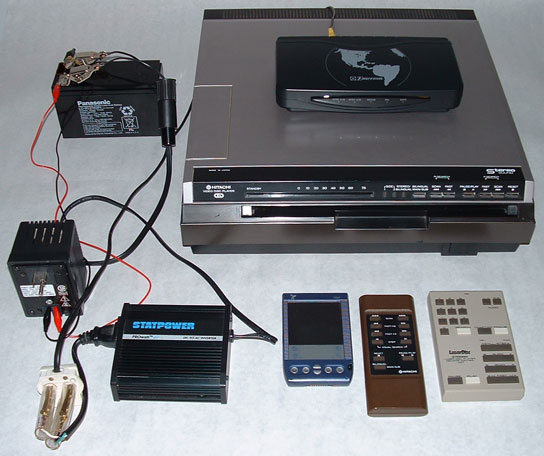
This page describes how to use PAL CED VideoDisc players to watch PAL/UK CED's in North America. Since NTSC players cannot play PAL discs, a PAL player is required to accomplish this. But PAL players operate at 230-240 Volts, 50 Hertz and output their video signal in the 4.43 MHz, 625-line PAL format. In contrast, North America uses 115-120 Volt, 60 Hertz AC power, and the video signal needs to be in the 3.58 MHz, 525-line NTSC format to properly display on standard TV's. It's actually possible to attach a PAL CED player directly to a North American TV and watch PAL CED's, but two problems will be apparent. Although the luminance signal is compatible between the PAL and NTSC standards, the chrominance signal is not, so the image will be in Black-and-White only. And since the PAL standard uses 625 lines rather than 525, the modern North American television will simply cut off 100 lines from the bottom and display the cropped image.
To overcome these problems, a video converter is needed to convert the PAL video signal to NTSC, and a voltage inverter is needed to power the PAL player at 230V, 50Hz. The best way to accomplish the latter is to use an inverter designed to provide 230V, 50Hz from the 12V accessory outlet in an automobile. The least expensive inverters of this type can typically supply 150 Watts of power, well in excess of the 20 Watts needed by a Hitachi player. This also means that only a small 12 Volt battery is needed to power the inverter. A sealed lead-acid battery of the type commonly used in computer uninterruptible power supplies (UPS's) will provide several hours of power to the player.
A photo of my complete setup used in conjunction with the Hitachi VIP201P player is shown in the photo above. The images and paragraphs below describe what each component does. This might seem like a lot of trouble just to watch PAL CED's in North America, but there are about ninety PAL titles that were only released in the UK. CED collectors in the UK have even more reason to do the reverse of what this page describes, as they will then have the ability to watch the large US CED library. In their case, a 12 V to 120 V, 60 Hz inverter is needed for all NTSC players except the J/K models. The J/K models can operate at either 50 Hz or 60 Hz, so these units only need a 230V-to-120V stepdown transformer to operate in the UK. The video converters described on this page can perform both PAL-to-NTSC and NTSC-to-PAL conversions.
As for player selection, any PAL player except the lowly and rare VIP101P and V5001H is acceptable, as all other models have composite video and left/right audio outputs. The composite video output goes to the video converter, while the left/right audio outputs go directly to the left/right audio inputs on the TV or stereo amplifier. The VIP201P is my preferred player, as it's the only PAL model to feature infrared remote control. Collectors in the United Kingdom should avoid NTSC players that have only channel 3/4 RF outputs. To play NTSC titles in the UK, I'd recommend the higher end J/K models like the SJT200 or above.
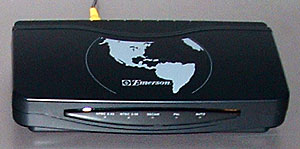
|
Multisystem Video Converter
The model shown is a CL1585 digital converter that converts 625 lines to 525 lines and 4.43 MHz to 3.58 MHz chrominance (or vice versa). This results in a complete color image from a PAL CED on an NTSC television. My first PAL converter purchased in the mid 1990's was a analog CL1575 model, which at that time was a lot less expensive than the digital type. This analog model performs the color conversion, but still outputs 625 lines. This wasn't a problem on the older TV I had it attached to, as the vertical hold knob could be adjusted to produce a stable image with no vertical roll. But modern TV's don't even have a vertical hold knob and simply truncate any lines above 525. Memory prices have dropped to the point that the 2 megabit frame buffer in the digital converters has negligible cost. so you aren't likely to find an analog converter in the modern time frame except as a used item. |
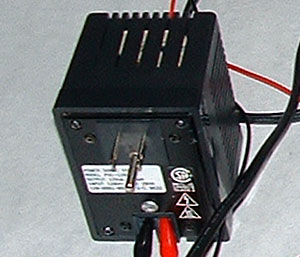
|
12-Volt Battery Charger
This is a "wall wart" style PSC-12800A battery charger from PowerSonic specifically designed to charge a 12V sealed lead-acid battery from a 120V household supply. This is a high-quality charger, as it measures the battery voltage, and automatically switches to a negligible float charge rate when the battery is fully charged. Avoid cheap chargers that output a constant charge current, as they can overcharge the sealed lead-acid battery if they are left connected too long. |
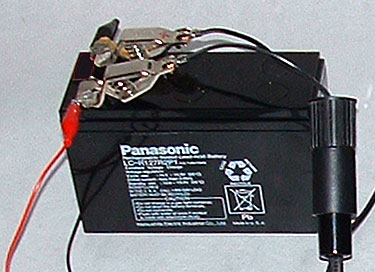
|
12-Volt Rechargeable Battery
This is a Panasonic LC-R127R2P sealed lead-acid battery of the type used in many computer UPS units. This battery is rated at 7.2 Ampere*hour, meaning it could supply 7.2 Amperes of current for one hour (although the rating is actually calculated over a 20 hour discharge cycle). The Hitachi players consume about 20 Watts of power with another 2 Watts being consumed by the power inverter. This translates to a discharge current of about 1.8 Amperes, meaning the battery can power the CED player for about 4 hours per charge, enough time to watch a couple CED movies. For maximum battery life, it is best to recharge the battery after watching each CED movie, as lead-acid batteries don't suffer from the "memory effect" associated with Ni-Cad batteries, and the life of a lead acid battery is reduced if it is subjected to frequent deep discharge. These sealed lead-acid batteries should be charged with a charger that automatically switches to a low float rate when the battery is fully charged. Although they can be charged with an unregulated unit, this can damage the battery if the charger isn't disconnected from the battery after the recommended length of time determined by the capacity of the battery and the rating of the charger. A voltmeter can also be used to monitor this manually, with the charger being disconnected when the voltage measurement with the charger active reaches 14.75V. The battery should then measure about 13.8V when it is disconnected from the charger. Eventually a battery will start leaking sulfuric acid if left permanently attached to an unregulated charger, so if you do use such a charger, be sure to put a glass or ceramic kitchen plate under the battery. |
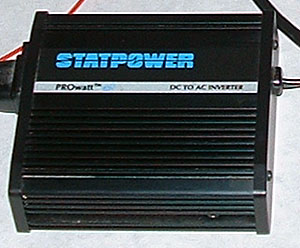
|
12V to 230V 50Hz Power Inverter
This is a Statpower PROwatt 150i voltage inverter that converts the 12V DC from the battery to 230V, 50Hz for the CED player. When purchasing an inverter, be sure to get one with "modified sine wave" output, as cheap inverters with a plain square wave output may not properly power the CED player. Another parameter to check is the accuracy of the frequency conversion. This older PROwatt 150i model is accurate to 0.05 Hertz, well within the tolerance of the Hitachi PAL players. This measure is particularly important for UK collectors using a NTSC F/G player, as these players must be operated at 60.0 Hz +/- 0.5 Hz. |
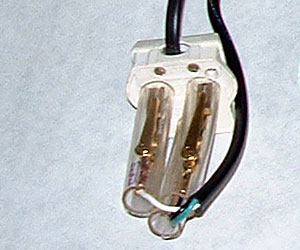
|
AC Plug from VIP201P Player
My VIP201P player has a UK power plug, which I attach to the PROwatt 150i inverter via insulated alligator clips. I use this setup, as it provides the versatility of attaching the PROwatt 150i to any style power plug or even a bare CED player power cord. CED power cords only have two wires, so it isn't really necessary to connect to the ground pin on the UK plug. Use caution when using power inverters. Even though they're powered by a modest 12 Volts, the output is still 230 Volts at potentially high current, enough to give a bad shock. |
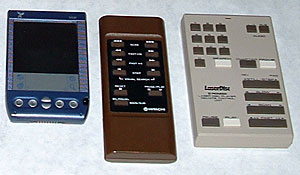
|
IR Remote Options for the VIP201P
Here are three alternatives for controlling the VIP201P player via infrared remote. On the left is a Palm handheld for which I have a downloadable program to operate the VIP201P. In the center is the original Hitachi remote supplied with the VIP201P, which is a difficult part to find today. On the right is an older Pioneer LaserDisc player RU-1000 remote that happens to use the same codes on some of its buttons as the Hitachi OEM remote. The remote must be from an early 1980's top-load Pioneer or Sylvania LaserDisc player to function with the Hitachi VIP201P player. Read the JP1 Page to learn about other VIP201P remote options. |
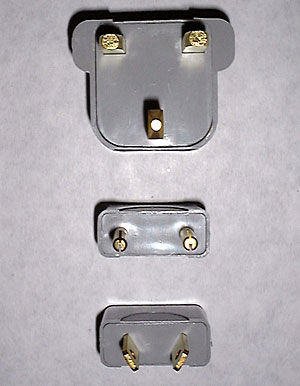
|
AC Plugs in PAL Countries
This image shows the three possible power plugs you may encounter on a PAL CED player. At top is the most common one, the UK power plug (also used in Hong Kong and some African countries). The top two pins go to neutral/line on the inverter, while the lower ground pin performs no function with CED players. The top left pin is neutral, and technically should go to the blue wire inside the CED player power cord, but in practice the line/neutral functions can be connected either way. At center is the plug style used in Europe as well as in many countries in Africa, Asia, and the Middle East. The plug style at the bottom is used in Australia and China. As with 2-prong AC connectors in the United States, the two wires inside the CED player power cord can be connected to the AC power either way and the player will still operate normally. |
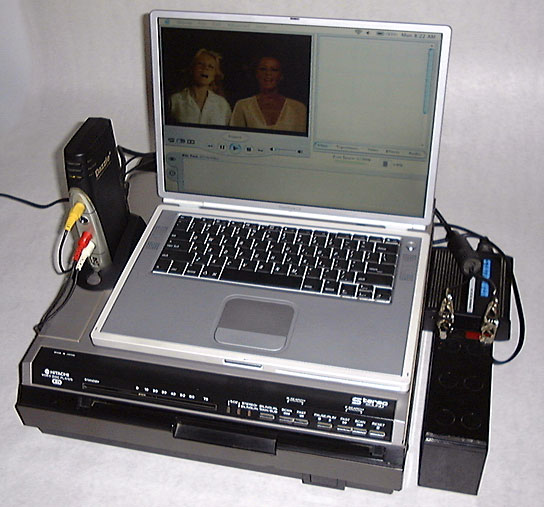
The emergence of the FireWire or IEEE 1394 computer I/O standard now allows CED players to be interfaced to computers using a device like the Dazzle Hollywood DV-Bridge to the left of the notebook computer. This device accepts the composite video and left/right audio outputs from either NTSC or PAL CED players, converting them to DV format for the FireWire port on the computer. The CED VideoDisc inside the player can then be watched on the computer screen. Some computers like the PowerBook shown have composite, S-Video, and DVI outputs, so the video from the CED player can alternatively be watched on a television. The advantage of using a DV-Bridge is that the same device can be used to both watch CED's and capture video from the discs or other sources. Note that the Dazzle Hollywood DV-Bridge has a video pass through connection that sends the CED video directly to an attached monitor. But this pass-through performs no conversion, so the output from a PAL player will be B&W on an NTSC TV with the bottom 100 lines truncated. The DV connector must be used to watch the video in untruncated color.